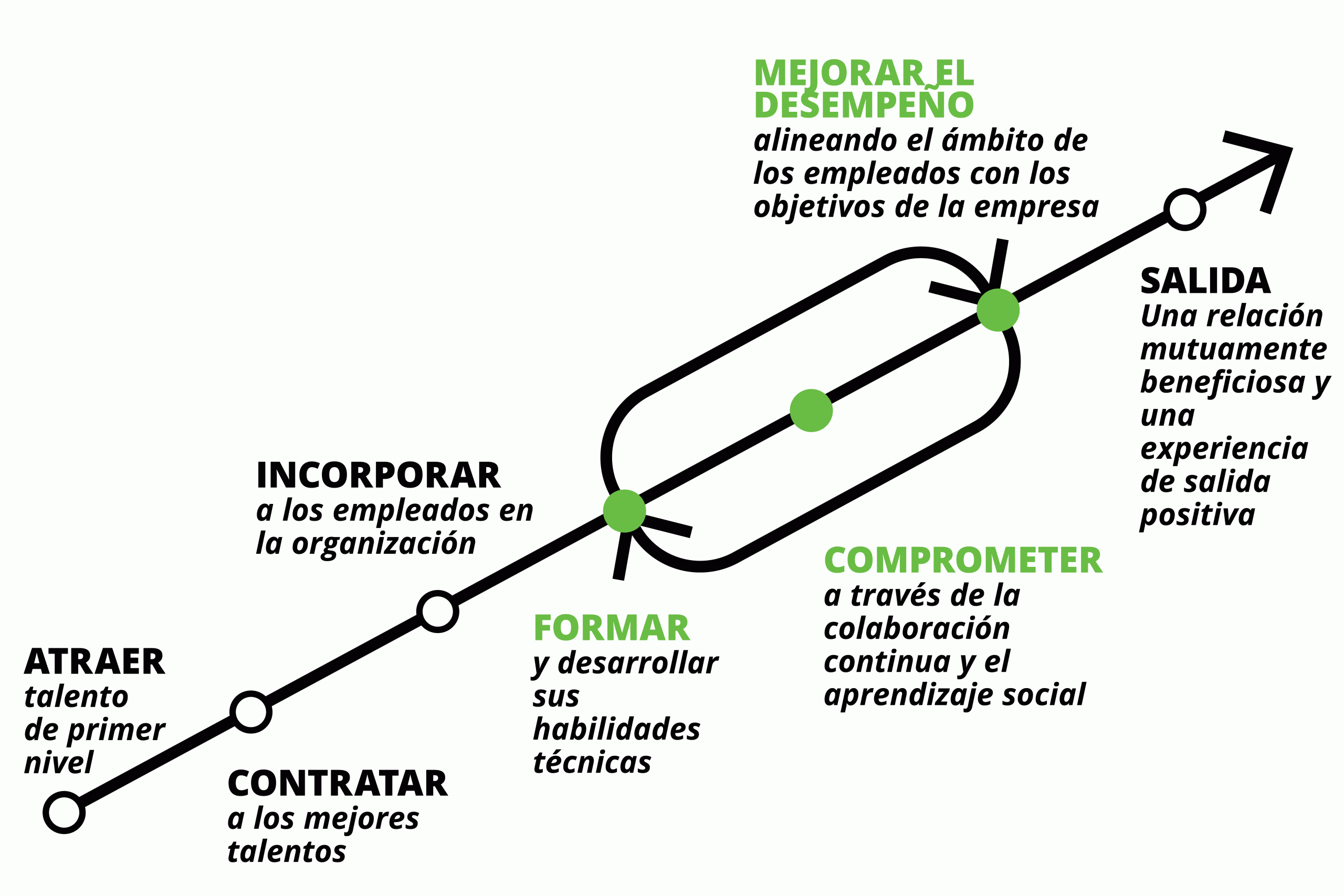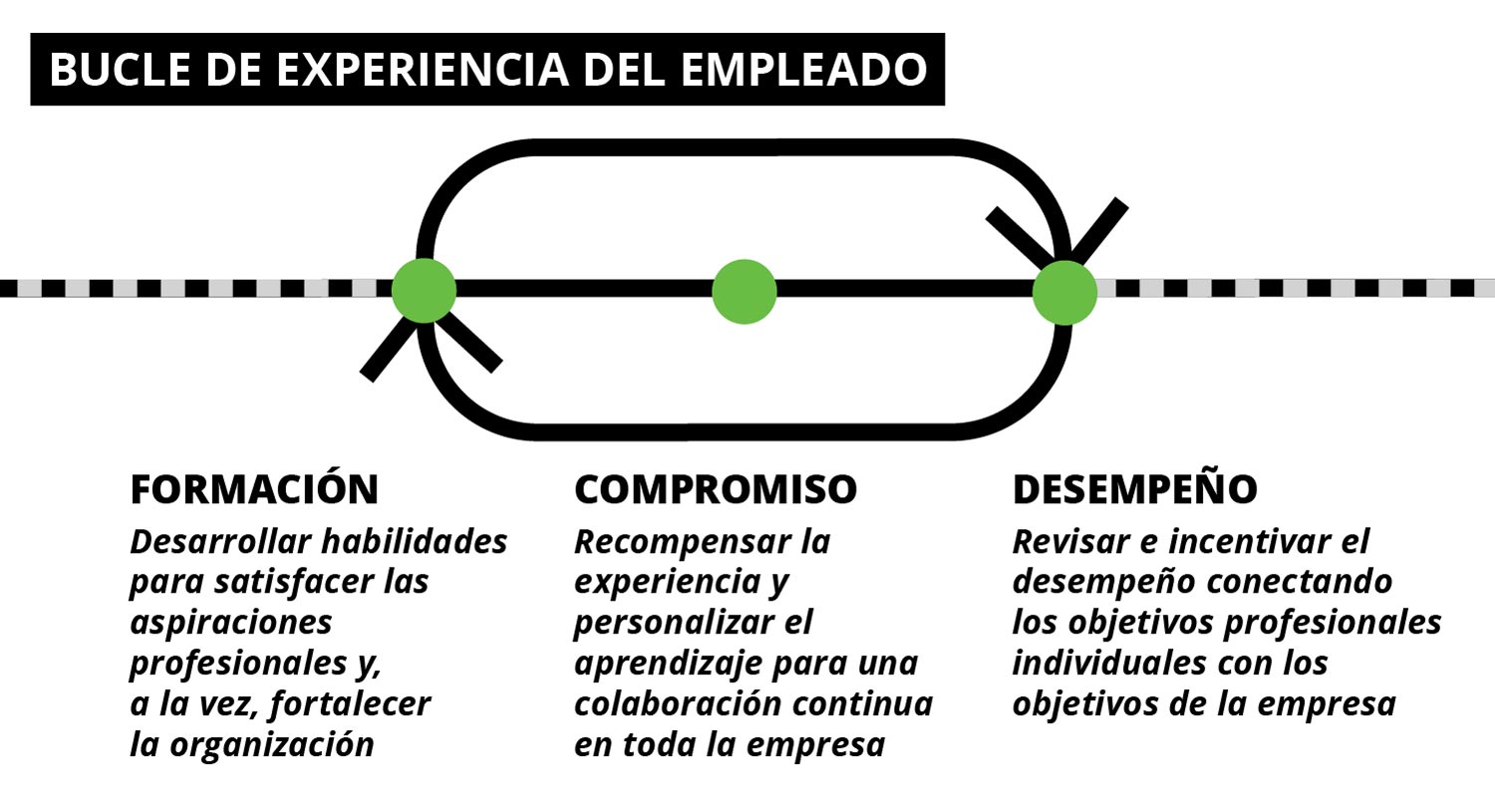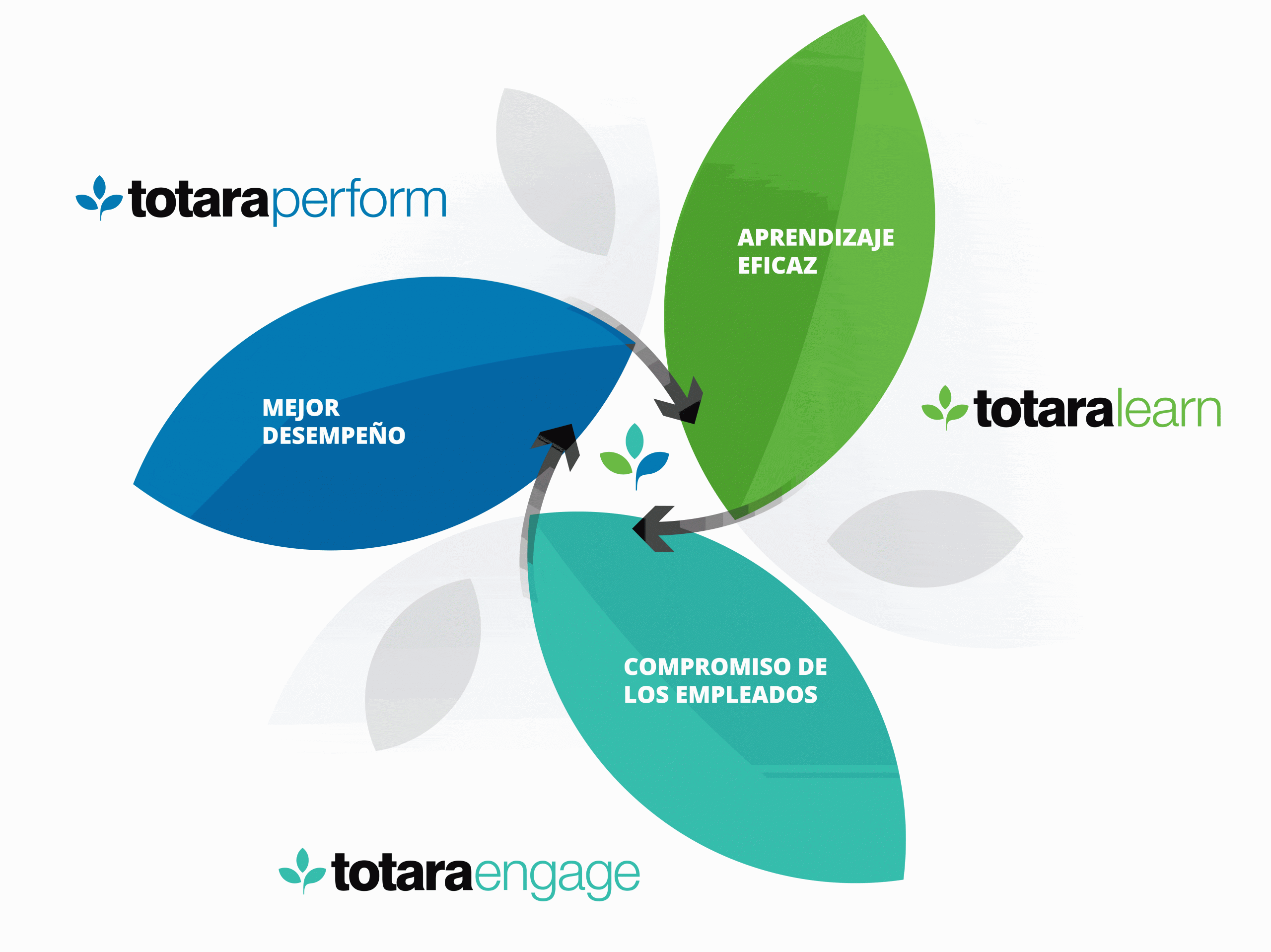How to improve employee experience with the help of technology
Choosing the wrong technology to improve the employee experience can affect your organization’s productivity.
A common mistake that many HR managers and directors fall into is that they do not have a good understanding of the company’s business model. The main reason for this is to choose employee collaboration tools based on superficial benefits, thinking that these are sustainable solutions that foster employee engagement and performance, but perhaps there has not been a deeper analysis.
Can collaborative learning tools contribute to generating high performance in the workplace or to generating an (often temporary) increase in engagement? Yes, it is undeniable.
However, transformational and sustained change in a workplace occurs when the most critical aspects of the employee experience are addressed (at Totara we call this the
talent experience
) through the following actions:
- Employee skills development
- Encouraging collaboration and knowledge sharing between teams
- Alignment of employee goals with organizational objectives.
Choosing technology that addresses these essential elements of the employee experience fosters an effective and collaborative growth culture, something that enables any organization to adapt to change and enhance the skills of its employees.
In this post, we present a breakdown of the best work tools to enhance the employee experience and create an adaptive, aligned and high-growth culture.
Table of contents:
- The difference between talent experience technology and employee experience technology
- 3 ways to use technology to improve the employee experience
No. 1: Invest in a better learning management system
No. 2: Encourage knowledge sharing and collaboration
No. 3: Use people-centric performance management technology - The all-in-one solution for optimal employee experience
Talent technology vs. employee experience technology: what’s the difference?
Employee experience is a broad definition of an employee’s perception of his or her workplace in relation to his or her experiences and touch points throughout the employee life cycle.
Therefore, technology focused on improving the employee experience could encompass anything from job candidacy to daily experiences, relationships with management, engagement, reimbursement, culture and rewards, among others.
Given the ambiguity of the term “employee experience,” at Totara we use the term talent experience to include the practical (and most influential) day-to-day aspects of the employee experience that influence employee engagement. These are:
- Learning and development: In addition to mandatory compliance training, do employees improve in their jobs or acquire the skills they need to develop and advance in their careers? Are they learning the skills that will benefit your organization in the future?
- Foster engagement and collaboration: Are employees able to collaborate and communicate effectively with each other? Can they find the hidden experts in the company who could provide solutions to the problems they face? Can they learn what they need, when they need it, in the workflow?
- Performance and mentoring: Is your performance management process tailored to individual needs? Does it provide continuous and timely feedback? Do employees understand how their day-to-day roles contribute to their individual goals, their team’s goals, and ultimately the organization’s goals?

Unlike the shiny but short-lived initiatives that many focus on (such as extravagant perks), focusing on these aspects and the technologies that support them produces a lasting ROI and makes it possible for employees to gain an optimal experience that drives exceptional organizational performance.
 3 ways to use technology to enhance the employee experience
3 ways to use technology to enhance the employee experience
Although we mention specific technologies to improve the employee experience in the workplace, these suggestions are based on the three fundamental “elements” of the talent experience they improve:
- Corporate training and employee development
- Fostering a culture of collaboration
- And ensure that performance management practices are aligned with employee and organizational objectives.
Enhancing the organization’s capabilities in any of these facets reinforces the corporate culture and will therefore help ensure the creation of an exceptional employee experience.
Speaking of culture, technology helps to amplify and extend the company’s culture, but it cannot replace it. Investing in the right technology for the employee experience is a big step forward, but to achieve meaningful change, the culture your organization fosters must guide all initiatives.
At a basic level, this means encouraging employees to embrace a culture of learning, innovation and continuous growth. Managers should adopt and implement an agile and open approach to performance management that promotes frequent feedback and honesty from employees.
That said, let’s explore the best ways to use technology to improve the employee experience in the organization:
No. 1: Investing in a better learning management system
Learning management system is one of the best technologies to improve employee experience for two reasons:
- Today, top-level employees are looking to achieve mastery
- Digitization is driving increased demand for competitive skills
When choosing a company to work for, nearly 87% of candidates consider learning and development opportunities in the workplace as key factors.
The study also shows that high-quality training increases employee engagement because it influences “psychological variables” such as:
- Motivation
- Participation
- Trust in the organization
For smart organizations, investing in learning and development technology such as an open source LMS goes beyond typical compliance training.
Rather than being seen as a cost of doing business, learning technology enables the organization to address skills gaps, provide staff with greater capacity and adaptability, improve development plans and reinforce employee skills. All this can generate a 14-29 % increase in profits.
No. 2: Fostering knowledge sharing and collaboration
When Mitchells & Butlers, the parent brand of more than 1700 hospitality establishments, fostered a collaborative environment through Totara, it achieved a clear improvement in engagement, performance and business results. Compliance rates reached 89% and food quality scores increased by 5% overall.
The Learning Experience Platform (LXP) is an optimal method of enhancing employees’ experience with technology by fostering collaboration, mentoring and professional development resources that support employees at every stage of their careers.
Recommended reading:
LMS or LXP: Which one is really needed?
From new employees to experienced managers, an LXP connects people with similar learning needs, whether by function, location, seniority level or skill set.
This not only helps staff to share knowledge, collaborate on projects and communicate with their peers, but also offers the opportunity to prepare employees for mentoring by high-level experts.
Experts can collect training resources from various channels to create customized development paths, answer learner questions and track learner engagement.
This provides employees with a dedicated place to develop their skills, share ideas with their peers and solve problems together in an engaging and interconnected way.
No. 3: Using people-centered performance management technologies
Improving employee skills and fostering a collaborative culture will dramatically improve the employee experience, but there is a final link in the experience chain missing to achieve an optimal level of performance:
Effective performance management.
Even if your employees are equipped with the right skills and well connected to their peers, achieving harmonization and getting employees to care about the organization’s goals can be difficult if:
- They have a dysfunctional or poor working relationship with management.
- They are not confident in their ability to progress in their careers.
- They do not have a way to express their work-related concerns.
- They feel that management is mismanaging or treating them inappropriately.
Supported by a people-centric management culture, a performance management system completes the talent experience chain, addresses the most impactful elements of the employee experience, and unlocks sustained employee engagement and alignment within the organization.
When choosing a performance management system to improve employee experience, we recommend a flexible technology (such as Totara Perform) that supports both an agile and traditional approach, and allows for incremental process improvements with features such as:
- 360-degree continuous feedback
- Support for frequent check-ins
- Updated competency frameworks and skills assessments
- Clear objectives and definition of objectives at all levels of the organization
Introducing Totara’s Talent Experience Platform: All-in-one technology for employee experience
At Totara, we’ve created the Talent Experience Platform to bring together all the employee experience technology you need in one comprehensive solution.
Totara’s Talent Experience Platform is comprised of three solutions that have proven their effectiveness individually and that acquire a transformative capacity when used together. The platform makes it possible to create a better working environment, increase adaptability and thrive in a world that is changing at breakneck speed. This platform combines:
- Totara Learn: the adaptive LMS trusted by millions of learners and used by companies around the world (such as Samsung and Indeed) to deliver transformative learning.
- Totara Engage: the learning experience platform (LXP) developed to enhance staff engagement, bonding and competencies. Totara Engage enables employees to simplify complex knowledge sharing through collaborative workspaces and Microsoft Teams integration.
- Totara Perform: with features for flexibility, organizational control and performance management, Totara Perform promotes maximum employee productivity.
 Together, these intuitive systems (which can be integrated with your existing people management, learning and development technology) form a talent experience platform that enhances every aspect of the employee-employer experience, enables peak performance and increases your organization’s agility.
Together, these intuitive systems (which can be integrated with your existing people management, learning and development technology) form a talent experience platform that enhances every aspect of the employee-employer experience, enables peak performance and increases your organization’s agility.


